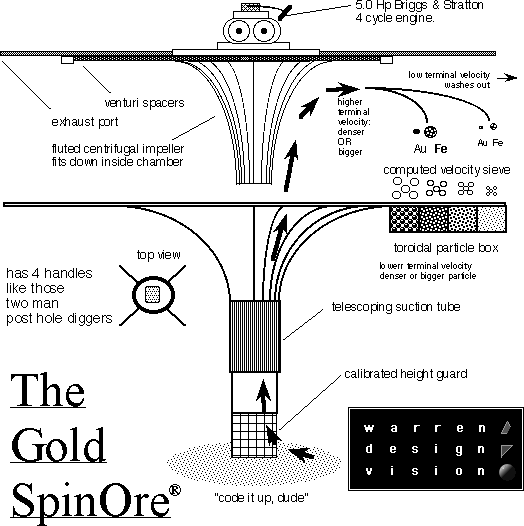 Panning for Gold - High Tech Style
Panning for Gold - High Tech Style Panning for Gold - High Tech Style
Panning for Gold - High Tech Style
My computer movie friend Rod, of "Fact vs. Fiction" fame, called me a while back. He said he had been "panning for gold" after the recent California floods. Seemed the weather conditions had brought on a torrent of water, freeing new deposits of gold to be discovered in the West Coast Yukon.
Being a novice rock hound, not immune to "gold fever", I started thinking about the problem. Some time passed. One weekend my daughter and I hit a great quartz vein on a construction site and dug out a bunch of double pointed crystals, some with little golden flecks of pyrite. I had wanted this to happen all my life, ever since the second grade, when all the kids but me got to go to the state capitol, ride the train, and get the geology kit. Our quartz bonanza reminded me of Rod's adventuring. Digging for quartz can be exciting, even our close knit family was ready to pounce ruthlessly when someone would yell out, "found one" during the dig. What lure could gold have?
So I called up Rod on the phone and we set about talking about panning and sluice boxes and all other kinds of separation techniques. We started getting fancy, no holds barred, microwaves, radar and generators. Getting fancy is what we do...
I became fixated on why gold survives the process of panning and decided it was because of the "terminal velocity" of a gold compared to the other debris in the mix. My conjecture was that gold remained in the pan because its terminal velocity in water was higher than other common minerals owing to its higher density.
So one Sunday, Rod and I talked all day trying to design machines that would separate silt from gold in a modern day Buster Keaton meets Rube Goldberg assault on Sutter's mill. I mean we had every device you could imagine, stacks of screens, suction guns, Archimedes screws. Big phone bill.
Along the way we came up with a way of thinking and talking about how gold sinks. If you're into it, it's a lot like a Monte Carlo simulation. Monte Carlo simulation is what you do when the system you want to simulate is complex. Instead of attacking it in a linear way, one pulls random numbers out of a hat and asked, "what happened when you feed it a 6". You can throw needles at a piece of graph paper and deduce the value of PI this way...
Anyway, we came up with a couple of ways of thinking about it:
Way 1:
Imagine you have two identically sized rocks. It doesn't matter how
big they are in absolute terms, only that they are the same size.
One is made of gold, the other is made of more common minerals. If
you threw them in air at the same initial velocity, how far would they go?
Well if you ask this question over and over again for different sizes of gold it gives you insight...
Way 2:
Imagine you have two different sized rocks, made of the same material.
If you threw them in air at the same initial velocity where would they land?
Now the trick is to ask these two questions for water instead of for
air, and to compute the distribution of diameters. If you know the
distribution of diameters then you can figure out exactly what size screen
to use (assuming that all little rocks are round). All that is left
is to suck silt off the river bottom and "throw" it at the right
speed across a sieve with the correct sized holes.
I typed in all the minerals in my little mineral handbook, the one with
the little rock hammer on it. I typed them into Excel and sorted them
by density.

Then I ran a simulation to find out what the sieve should look like.
It gets pretty sophisticated, but an interesting result that came out was
that a gold particle falls 57% faster than an iron particle of equivalent
size.
I ran off and designed a gizmo, with Rod's encouragement and support.
The result was something I called, "The Gold Spinner", after the
Rumplestiltsken story. This is a real machine that could be handled
by one or two people. The problem here is to suck silt off the river
bed and sort it in real time. I have split the machine into a top
and bottom section for clarity. It looks like a mushroom with a lawn
mower engine on top. Not shown is an inner tube skirt that keeps it
top side up:

Pull the handle and start accumulating gold. An upside down washing machine agitator is mounted in the center as a silt flinger. Silt is sorted into size categories in the first pass. In the second pass each size category is reflung to sort out the gold in them thar hills. A power rotary sluicer of sorts. The four handles around the perimeter help to control it in the water, like those two man post hole diggers you see at the Rent-All.
Contact: lvwarren@ wdv.com for further information.